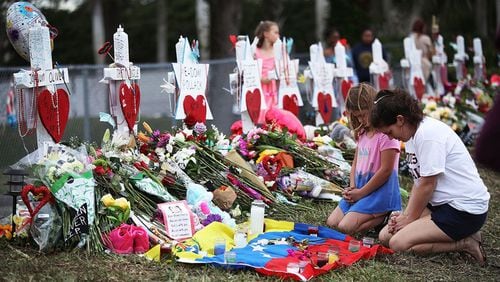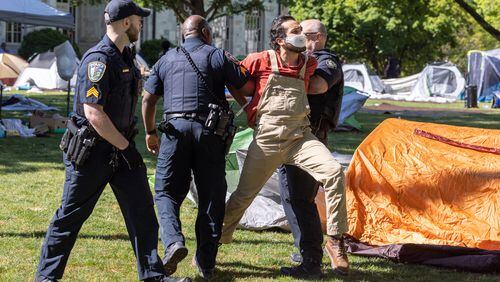Educators are offering their own solutions to preventing more school shootings. Here are the suggestions of Ben Needle, a history teacher at Wheeler High School in Cobb County.
By Ben Needle
With every school shooting, I struggle as an educator. What can we do and what have we done?
My training as an educator coincided with the shootings in Columbine -- 1999, the year that school shootings became a reality. Now that I am a seasoned educator I have an obligation to see that we do more. Teachers, students, administrators, and policymakers are all obligated to do more. However, in my opinion, politics get in the way of progress. Jockeying by pro and anti-gun groups cause us continually to spin our tires mired in the mud of progress. We have to change direction.
With this in mind, here are some of my thoughts:
Suspensions – We have zero tolerance programs in place. I like knowing that there is a strict policy in place and schools will follow through on what we say we will do to students if they violate policies. However, we know what we do TO students (ISS, OSS, Expulsion) but what do we do FOR students? What do we do when they are suspended to keep them from becoming disenfranchised? How can we care for them ways that they are not disconnected from the school during suspensions? And what do we do for them when they come back? Do we create a path that will lead them back to educational opportunity or one that will send them to failure? If we knew we could spend more money on these students to make sure they are cared for, what would we be willing to spend?
Guns – The second we use the word “gun” people on both sides get defensive. While it is impossible to have a school shooting without guns, that is not the cause of these issues. Mental health is the issue. If we attack guns, we are too late in the game. We must address the people before we address the weapons. When we start by addressing the weapons, we have already lost a large segment of the population because they feel threatened.
Calling it for what It Is – Our country is not colorblind but we like to claim we are. From police officers to retail to education to walking down the street, we contend everyone is viewed and treated equally. However, if we are being completely honest, race is an issue and we have to be OK with saying that. We must be honest about race in discussing mass school shootings. These shootings are a sickness of suburban white males. People of all races perpetuate gun violence but when it comes to events like what happened at Stoneman Douglass High School, it follows a historic pattern.
Mental Health –From students impacted by it to teachers to administrators, there is a misunderstanding of the control that mental health disorders have on students. These kids are not “crazy” or just “sad.” They are dealing with serious issues, and we must treat them accordingly. We need to educate all stakeholders about these issues and that people need our help to work through their mental health challenges. While education courses do a fine job of teaching pedagogical theory, they fall short on how to deal with the emotional wellbeing of children.
Counselors – What is the job of a school guidance counselor? To guide? To counsel? To advise? The reality is the most important part of a counselor’s job is to form relationships with students and this is the last thing they get to do. The American Association of School Counselors suggests a ratio of 250 students to one counselor. However, the state average in 2014-2015 was 484 students to a single counselor. This is the “easiest” area of need to solve. It is just money to hire more school counselors.
See something, say something – I have heard at far too many schools and jokes amongst students the phrase “snitches get stitches.” Whether serious or not, there is an issue with students externalizing fears they have or abnormal actions they see or hear about. Whether in school or on social media, we need to a better job of marketing the mantra “see something, say something.” Repeatedly, students have said, “Yeah, we figured it would be him” or “We are not surprised it was him.” We need to make sure voices are heard and students know it is incumbent upon them to do something. Additionally, much like the requirements of being a mandated reporter for a teacher, there must be a protocol to follow so we can assess the seriousness of these accusations.
Suspensions – We need to do a better job of doing “for” students and not just “to” students. Zero tolerance policies mean that when students violate policies, specifically with violence, drugs, or weapons, the judgement is swift and severe. I do not necessarily disagree with these policies. However, we need to do a better job of doing “FOR” suspended kids once we have done “TO” them. Perhaps, we should consider programs that focus on the concept of “Restorative Justice.” When we ignore the kids getting suspended, it should not be surprising they continue a trend of poor behavior. Will these kids end up bringing guns to school? Statistically, the answer is “no.” However, if we were to look at people who are incarcerated and ask if they had been suspended, most would answer “yes.”
Safety Protocols – I think schools are working on something that could help with our Code Red procedures. However, we still have too many holes in the process. If we lock all the doors, will that keep a student from opening the door to an outside force? The natural reaction when there is a knock at the door is to open it. Do shooters come to school dressed in what looks like tactical gear and a ski mask? Not typically. They are usually dressed how they would be on any given day. If we want to test and see if a locked door is a secure door, send a stranger to any high school and have them knock on a door that is not a primary access point. See how long it takes a kind student to let them into the building. See how far that stranger can get before someone stops them. We need to do a better job of training our students to be vigilant.
Police precincts – Perhaps an outlandish idea but why not put it out there. If we do not think outside the box, we will be in the same place 20 years from now. What if police precincts or substations were located in schools? Shooters do not walk into heavily armed locations because they know they will be shot immediately.
We CANNOT stop all violence. However, if we could stop one Nikolas Cruz or one Dylan Klebold, we are saving thousands of students, families, communities from being traumatized.
We need people from all over the political spectrum to decide that Georgia will set the standard for ensuring our students will not deal with these issues in the future. We will not solve this issue overnight. It will take time. It will take compromise. We will succeed. We must succeed.
My children, your children, our grandchildren depend on us.







